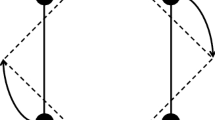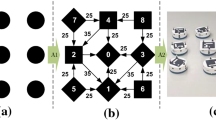Abstract
In this paper, we define Proteo as a class of three-dimensional (3D) metamorphic robotic system capable of approximating arbitrary 3D shapes by utilizing repeated modules. Each Proteo module contains embedded sensors, actuators and a controller, and each resides in a 3D grid space. A module can move itself to one of its open neighbor sites under certain motion constraints. Distributed control for the self-reconfiguration of such robots is an interesting and challenging problem. We present a class of distributed control algorithms for the reconfiguration of Proteo robots based on the “goal-ordering” mechanism. Performance results are shown for experiments of these algorithms in a simulation environment, and the properties of these algorithms are analyzed.
Similar content being viewed by others
References
Bojinov, H., Casal, A., and Hogg, T. 2000. Emergent structures in modular self-reconfigurable robots. In Proc. IEEE International Conference on Robotics and Automation, San Francisco, CA. pp. 1734–1741.
Chirikjian, G. 1993. Metamorphic hyper-redundant manipulators. In Proc. JSME International Conference on Advanced Mechatronics, pp. 467–472.
Chirikjian, G., Pamecha, A., and Ebert-Uphoff, I. 1996. Evaluating efficiency of self-reconfiguration in a class of modular robots. Journal of Robotic Systems, 13(5):317–338.
Fukuda, T. and Kawauchi,Y. 1990. Cellular robotic system (CEBOT) as one of the realization of self-organizing intelligent universal manipulator. In Proc. IEEE International Conference on Robotics and Automation, pp. 662–667.
Hamlin, G. and Sanderson, A. 1996. Tetrobot modular robotics: Prototype and experiments. In Proc. IEEE/RSJ International Symposium of Robotics Research, Osaka, Japan, pp. 390–395.
Hosokawa, K., Tsujimori, T., Fujii, T., Kaetsu, H., Asama, H., Kuroda, Y., and Endo, I. 1998. Self-organizing collective robots with morphogenesis in a vertical plane. In Proc. IEEE International Conference on Robotics and Automation, Leuven, Belgium, pp. 2858–2863.
Kotay, K., and Rus, D. 1999. Locomotion versatility through self-reconfiguration. Robotics and Autonomous Systems, 26(2–3):217–232.
Latombe, J.-C. 1991. Robot Motion Planning, Kluwer: Dordrecht, Netherlands.
Murata, S., Kurokawa, H., and Kokaji, S. 1994. Self-assembling machine. In Proc. IEEE International Conference on Robotics and Automation, pp. 441–448.
Murata, S., Kurokawa, H., Yoshida, E., Tomita, K., and Kokaji, S. 1998. A 3D self-reconfigurable structure. In Proc. IEEE International Conference on Robotics and Automation, Leuven, Belgium, pp. 432–439.
Nguyen, A., Guibas, L., and Yim, M. 2000. Controlled module density helps reconfiguration planning. In Workshop on the Algorithmic Foundations of Robotics, pp. TH15-TH27.
Pamecha, A., Chiang, C., Stein, D., and Chirikjian, G.S. 1996. Design and implementation of metamorphic robots. In Proc. ASME Design Engineering Technical Conference and Computers in Engineering Conference, Irvine, California.
Pamecha, A., Ebert-Uphoff, I., and Chirikjian, G.S. 1997. Useful metrics for modular robot motion planning. In Proc. IEEE Transactions on Robots and Automation, 13(4):531–545.
Paredis, C. and Khosla, P. 1993. Kinematic design of serial link manipulators from task specifications. International Journal of Robotic Research, 12(3):274–287.
Rus, D. and Vona, M. 1999. Self-reconfiguration planning with compressible unit modules. In Proc. IEEE International Conference on Robotics and Automation, Chicago, IL, pp. 2513–2520.
Rus, D. and Vona, M. 2000. A physical implementation of the self-reconfiguring crystalline robot. In Proc. IEEE International Conference on Robotics and Automation, San Francisco, CA, pp. 1726–1733.
Unsal, C. and Khosla, P. 2000. Mechatronic design of a modualr selfreconfiguring robotic system. In Proc. IEEE International Conference on Robotics and Automation, San Francisco, CA, pp. 1742–1747.
Walker, I. and Cavallaro, J. 1999. Keeping the analog genie in the bottle: A case for digital robots. In Proc. IEEE International Conference on Robotics and Automation, Chicago, IL, pp. 1063–1070.
Will, P., Castano, A., and Shen, W.-M. 1999. Robot modularity for self-reconfiguration. In SPIE International Symposium on Intelligent Systems and Advanced Manufacturing Proc., Vol. 3839, pp. 236–245.
Yim, M. 1994. New locomotion gaits. In Proc. IEEE International Conference on Robotics and Automation, San Diego, CA, pp. 2508–2514.
Author information
Authors and Affiliations
Rights and permissions
About this article
Cite this article
Yim, M., Zhang, Y., Lamping, J. et al. Distributed Control for 3D Metamorphosis. Autonomous Robots 10, 41–56 (2001). https://doi.org/10.1023/A:1026544419097
Issue Date:
DOI: https://doi.org/10.1023/A:1026544419097




